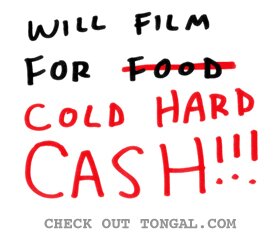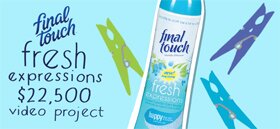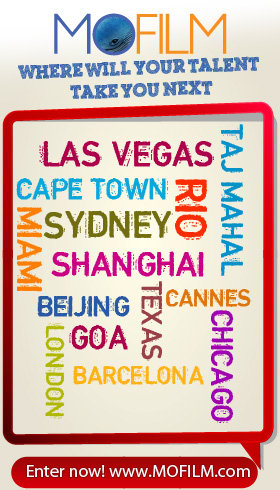Beardy’s Note: Today I’m happy to present our third-ever guest blog post. And it’s actually the first installment in a three part series about lighting low budget video projects! The series is being written by video contest filmmaker and cinematographer, Jeremy Applebaum. I’ve worked with Jeremy on a few shoots and the guy certainly knows his stuff. Last year he handled the lighting for my Crash the Super Bowl entry and I was really impressed with the work he did. The video was shot outdoors at night next to a campfire so it was an incredibly difficult scene to light. But check out the final product! Like I said, the guy knows his stuff. Oh, and Jeremy also just released iPhone app for filmmakers! Ok, on with the post…
Lighting on a small budget can be a real challenge. But a nice, professional look doesn’t have to cost you a fortune. In fact, most of what you need can be picked up cheap at your local hardware store. In this installment of the lighting guide, we’ll present some items that every low budget filmmaker should have at their disposal.
Section One: Background Information:
Before we go into the gear, some basic lighting terminology knowledge is needed:
1: A Key Light, the strongest source in your scene.
2: A fill light, a light not as powerful as the key but used to fill in the darker spots.
3: A back or accent light, a light pointed at the back of your subject to make them pop.
4: A background light, a light pointed at the background so it doesnʼt turn into black mush.
A typical set will have one key light, a few fill lights, several accent lights, and one to two background lights. All these different lighting sources can purchased inexpensively and off the self at various retailers.
Section Two: Lighting Fixtures:
Disclaimer: It needs to be said that all of this lights can get very hot, so please be careful and use caution when moving and touching these lights.

work it.
The most common low budget (hardware store) light in use would be the work light. At anywhere from $4.99 (and up) for 500 (and up) watts of these are quite a steal. Even more so when you consider that Lowel Tota lamps (bulbs in film are called lamps) can be used instead of the lamp that comes with it. Work lights are great for lighting a broad area and can be used for anything from key lights, fill lights/accent, and background lights. The main disadvantage of these lights are that they are very difficult to control and unless softened somehow they emit a very harsh quality of light.
Another common low budget light you will see in use would be the paper lantern. These are great as soft fill lights. At around $25 for the whole fixture (lantern, socket, and lamp) these, while a bit pricier than the work light, are still a great deal. Paper lanterns are great for providing a great soft fill light to your scene. The main disadvantage here is that the only thing they will do is provide soft light and can not be easily controlled or shaped. They also have a huge safety issue, while unlikely, since they are made of paper, if the bulb is too close or touching the sides, the lantern could light on fire.

The Clamps!
The last lighting fixture on this list is an absolute gem and largely unknown to the low budget, DIY type crowd, and this would be the clamp light. While you can get by with one to two work lights, and a china ball, you will need several more clamp lights if you really want to get serious about lighting your scene. At $7.99 (and up, without a lamp) these can get quite pricey. Clamp lights are great because, like the name suggests, they can be clamped almost anywhere making them great for for fill, accent, backlights, and in a pinch, enough of them can provide enough punch to provide a solid key light. A safety issue that should be said is that just because they can be clamped anywhere doesn’t mean they should, always make sure your lights are secure before walking away from them. When in doubt donʼt leave it.
Section Three: Accessories and Lighting Control:
Below are several great options out there for shaping and controlling your lighting sources.

Another clamp!
C Clamps: C clamps are great for rigging pieces of gear in spots that you couldnʼt get them normally.
Foam Board: White foam board can used to bounce light onto your subjects (experiment by pointing your work lights at something and then try again, this time pointing your work light at some white foam board and bouncing it back to truly see the effect). Black foam board can be used block (or called flagging) parts of light that you donʼt want hitting your subject.
Clothes Pins: Clothes pins (c-47s) are great for clipping parchment paper to your lights.
Gloves: Gloves (or pot holders!) are needed to handle and move your lights during a shoot.
Tin Foil: Tin foil makes a great shiny reflector. The main difference between tin foil and white foam board is that tin foil will bounce back a more powerful and harsher light. To make a cheap all-in-one bounce board, tape or glue some tin foil to one side on your white foam board.

More clamps? WTF?
Pony Clamps: Pony clamps are used like clamps for rigging gear, except where c clamps excel at clamping lights, pony clamps are better for clamping foam board and helping secure clamp lights.
Parchment Paper: Parchment paper makes a great diffuser, clip in front of a work light or clamp light to soften it. Be careful not to clip it too close so it doesnʼt get too hot and start burning up.
Tape: Masking tape and duct tape are a requirement to have on hand on any set.
Case: You will also need some sort of case to carry all your gear in. I personally use work totes but almost anything should work. Just be careful how you pack your lamps. You donʼt want to open your case to find smashed lamps and broken glass.
Power: No lighting kit would be complete without its share of power distribution options. Since most low budget options generally tend to have short cords it would be a good idea to always have a few extension cords (called stingers on a film set) and surge protecters/multi taps on hand to split the power. Furthermore dimmers are great for controlling your fixtures output.
Lamps: You will need a few different lamps to put in your clamp lights and paper lanterns (work lights come with one to two in the box). It would be good to have several lamps on hand of different color temperatures and wattages. Make sure you always bring a spare to set you with, you never know when a lamp is going to blow.
Next friday we’ll cover basic electrical safety in Part Two and then in Part Three were we go over some basic lighting techniques. If you liked this article, have any questions, or think I missed anything please speak up below.
— Guest Post by Jeremy Applebaum. Check out Jeremey’s “Virtual AD” app —



















